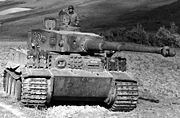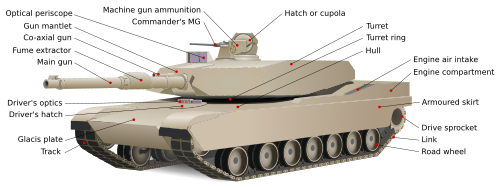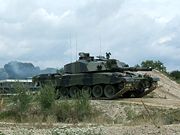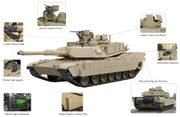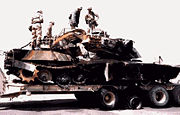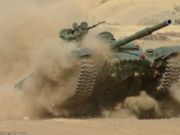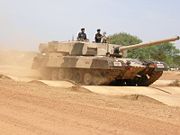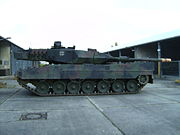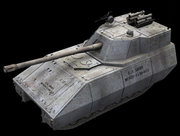Tank
2008/9 Schools Wikipedia Selection. Related subjects: Military History and War
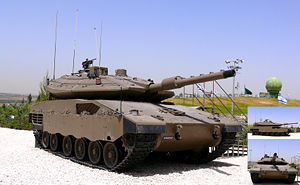

A tank is a tracked, armoured fighting vehicle designed for front-line combat and combines strong strategic and tactical offensive and defensive capabilities. Firepower is normally provided by a large- calibre main gun in a rotating turret and secondary machine guns, while heavy armour and all-terrain mobility provide protection for the tank and its crew, allowing it to perform all primary tasks of the armoured troops on the battlefield.
Tanks were first manufactured during World War I in an effort to break the bloody deadlock of trench warfare. The British Army was the first to field a vehicle that combined three key characteristics: mobility over barbed wire and rough terrain, armour to withstand small arms fire and shrapnel and the firepower required to suppress or destroy machine gun nests and pillboxes. Despite some success and a significant psychological effect on the German infantry, "the tank in 1918 was not a war-winning weapon."
Interwar developments culminated in the blitzkrieg employed by the German Wehrmacht during World War II and the contribution of the panzers to this doctrine. Hard lessons learned by the Allies during WWII cemented the reputation of the tank, appropriately employed in combined arms forces, as "indispensable to success in both tactical and strategic terms." Today, tanks seldom operate alone, being organized into armoured units and operating in combined-arms formations. Despite their apparent invulnerability, without support, tanks are vulnerable to anti-tank artillery, helicopters and aircraft, enemy tanks, anti-tank and improvised mines, and (at close range or in urban environments) infantry.
Due to its formidable capabilities and versatility the battle tank is generally considered a key component of modern armies, but recent thinking has challenged the need for such powerful and expensive weaponry in a period characterized by unconventional and asymmetric warfare. Ongoing research and development attempts to equip the tank to meet the challenges of the 21st century.
History
The first proposal for a tank was by the Austrian Oberleutenant Günther Burstyn who, in 1911, proposed a design for "motor artillery" (Motorengeschütz) with a turret, but his design never progressed beyond a German patent in 1912.
Tank or "landship" development, originally conducted by the British Navy under the auspices of the Landships Committee was sponsored by the First Lord of the Admiralty, Winston Churchill and proceeded through a number of prototypes culminating in the Mark I tank prototype, named Mother. The first tank to engage in battle was designated D1, a British Mark I, during the Battle of Flers-Courcellette on 15 September 1916.
In contrast to World War II, Germany fielded very few tanks during WWI, with only 15 of the A7V type being produced in Germany during the war. The first tank versus tank action took place on 24 April 1918 at Villers-Bretonneux, France, when three British Mark IVs met three German A7Vs.
Mechanical problems, poor mobility and piecemeal tactical deployment limited the military significance of the tank in World War I and the tank did not fulfil its promise of rendering trench warfare obsolete. Nonetheless, it was clear to military thinkers on both sides that tanks would play a significant role in future conflicts.
Interwar years
In the interwar period tanks underwent further mechanical development and, in terms of tactics, J.F.C. Fuller's doctrine of spearhead attacks with massed tank formations was the basis for work by Heinz Guderian in Germany, Percy Hobart in Britain, Adna R. Chaffee, Jr. in the U.S., Charles de Gaulle in France, and Mikhail Tukhachevsky in the USSR. All came to similar conclusions, but in the Second World War only Germany would initially put the theory into practice on a large scale, and it was their superior tactics and French blunders, not superior weapons, that made blitzkrieg so successful in May 1940. For information regarding tank development in this period, see tank development between the wars.
Germany, Italy and the Soviet Union all experimented heavily with tank warfare during their clandestine and “volunteer” involvement in the Spanish Civil War, which saw some of the earliest examples of successful mechanized combined arms—such as when Republican troops, equipped with Soviet-supplied medium tanks and supported by aircraft, eventually routed Italian troops fighting for the Nationalists in the seven-day Battle of Guadalajara in 1937.
Blitzkrieg and combined arms
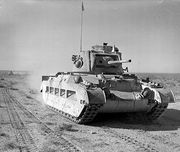
World War II was the first conflict where armoured vehicles were critical to success on the battlefield and during this period the tank developed rapidly as a weapon system. During the Invasion of Poland the Panzer II and the captured Czechoslovakian Panzer 38(t) light tanks predominated. The Somua S35 and Char B1 in the French Army and the Panzer III and Panzer IV medium tanks appeared in numbers during the Battle of France, while the North African Campaign brought the British Crusader and Matilda into combat with the panzers. In Operation Barbarossa the Wehrmacht encountered the Soviet T-34 and this prompted development so that during the Invasion of Normandy from June 1944 the Germans were fielding the Panther and Tiger tanks against the Allied Sherman. By 1945 and the final stages of the war the Tiger II, Pershing and Iosif Stalin tanks dominated the battlefields where they saw action.
During WWII the tactics and strategy of deploying tank forces underwent a revolution. Heinz Guderian, father of the German panzer forces, said "Where tanks are, the front is", and this concept became a reality in WWII. Following the Invasion of Poland where tanks performed in a more traditional role in close cooperation with infantry units, in the Battle of France deep independent armoured strategic penetrations were executed by the Germans, a tactic later called Blitzkrieg or 'lightning war'. Early war German tanks sacrificed firepower and protection for mobility and reliability. Blitzkrieg made use of innovative combined arms tactics and radios in all of the tanks to provide command and control which made them more effective tank for tank than their Allied opponents, despite the Allied machines being more than a match for the panzers one-on-one. The French Army, with tanks equal or superior to the German tanks in both quality and quantity employed a linear defensive strategy to which the armoured cavalry units were made subservient. The French also had poor command and control systems, lacking radios in many of their tanks and headquarters. In accordance with the tactics of blitzkrieg, German tanks bypassed enemy strongpoints and could radio for close air support to destroy them, or leave them to the infantry on foot. A related development, mechanized infantry, allowed some of the troops to keep up with the tanks and create highly mobile combined arms forces.
Operation Barbarossa started with the Soviets having a superior tank design, the T-34, but a lack of preparations for the Axis surprise attack, mechanical problems, poor training of the crews and incompetent leadership caused the Soviet machines to be surrounded and destroyed in large numbers. However, the geographic scale of the conflict, the dogged resistance of the Soviet combat troops, Soviet manpower and production capability and the Russian Winter prevented a repeat of the Blitzkrieg of 1940. Despite early successes against the Soviets, the Germans were forced to up-gun their Panzer IVs, and design and build larger and more expensive Panther and Tiger tanks. In doing so the Wehrmacht denied the infantry and other support arms the production priorities that they needed to remain equal partners with the increasingly sophisticated tanks, in turn violating the principle of combined arms that they had pioneered. In the meantime, the Soviets ramped up T-34 production for a huge quantitative advantage.
When entering WWII American mass production capacity enabled her to rapidly construct thousands of relatively cheap Sherman tanks. A compromise all round, the Sherman was reliable and formed a large part of the Anglo-American ground forces, but in a tank vs tank battle they were no match for the German Panther and Tiger tanks. Numerical and logistical superiority and the successful use of combined arms allowed the Allies to overrun the German forces during the Battle of Normandy. The Sherman Firefly was introduced to improve the Sherman's firepower, but concerns about protection remained.
Tank chassis were modified to produce flame tanks, mobile rocket artillery and combat engineering vehicles for tasks including mine-clearing and bridging. Specialised self-propelled guns were also developed: tank destroyers and assault guns were cheap, stripped down tanks carrying heavy guns, often in a fixed hull mounting. The firepower and low cost of these vehicles made them attractive but as manufacturing techniques improved and larger turret rings made larger tank guns feasible, the gun turret was recognised as the most effective mounting for the main gun to allow movement in a different direction from firing, enhancing tactical flexibility.
The Cold War arms race
During the Cold War, tension between the Warsaw Pact countries and NATO countries created an arms race that ensured that tank development proceeded largely as it had during WWII. The essence of tank designs during the Cold War had been hammered out in the closing stages of World War II. Large turrets, capable suspension systems, greatly improved engines, sloped armour and large-calibre (90 mm and larger) guns were standard. Tank design during the Cold War built on this foundation and included improvements to fire control, gyroscopic gun stabilisation, communications (primarily radio) and crew comfort and saw the introduction of laser rangefinders and infrared night vision equipment. Armour technology progressed in an ongoing race against improvements in anti-tank weapons, especially antitank guided missiles like the TOW.
Medium tanks of WWII evolved into the main battle tank (MBT) of the Cold War and took over the majority of tank roles on the battlefield. This gradual transition occurred in the 1950s and 60s due to anti-tank guided missiles, sabot ammunition and high explosive anti-tank warheads. WWII had shown that the speed of a light tank was no substitute for armour and firepower and heavy tanks were as vulnerable as medium tanks to newer weapon technology, rendering them obsolete.
In a trend started in WWII, economies of scale led to serial production of progressively upgraded models of all major tanks during the Cold War. For the same reason many upgraded post-WWII tanks and their derivatives (for example, the T-55 and T-72) remain in active service around the world, and even an obsolete tank may be the most formidable weapon on battlefields in many parts of the world. Among the tanks of the 1950s were the British Centurion and Soviet T-54/55 in service from 1946, and the US M48 from 1951. These three vehicles formed the bulk of the armoured forces of NATO and the Warsaw Pact throughout the Cold War. Lessons learned from tanks such as the Leopard 1, M60 Patton, Chieftain, and T-72 led to the contemporary Leopard 2, M1 Abrams, Challenger 2, T-90 and Merkava IV.
Tanks and anti-tank weapons of the Cold War era saw action in a number of proxy wars like the Korean War, Vietnam War, Soviet war in Afghanistan and Arab-Israeli conflicts culminating in the Yom Kippur War. The T-55, for example, has seen action in no fewer than 32 conflicts. In these wars the USA or NATO countries and the Soviet Union or China consistently backed opposing forces. Proxy wars were studied by Western and Soviet military analysts and provided a grim contribution to the Cold War tank development process.
21st century
As of 2005, there were 1,100 M1 Abrams used by the United States Army in the course of the Iraq War, and they have proven to have an unexpectedly high level of vulnerability to roadside bombs. A relatively new type of remotely-detonated mine, the explosively formed penetrator has been used with some success against American armoured vehicles (particularly the Bradley fighting vehicle). However, with upgrades to their armour in the rear, M1s have proven invaluable in fighting insurgents in urban combat, particularly at the Battle of Fallujah, where the Marines brought in two extra brigades. Britain deployed its Challenger 2 tanks to support its operations in southern Iraq.
Tank design
The three traditional factors determining a tank's effectiveness in battle are its firepower, protection, and mobility. In practical terms, the cost to manufacture and maintain a given tank design is also important in that it determines how many tanks a nation can afford to field.
Firepower is the ability of a tank to identify, engage, and destroy a target. Protection is the tank's ability to resist being detected, engaged, and disabled or destroyed by enemy fire. Mobility includes tactical (short range) movement over the battlefield including over rough terrain and obstacles, as well as strategic (long range) mobility, the ability of the tank to be transported by road, rail, sea, or air to the battlefield.
Tank design is a compromise; it is not possible to maximize firepower, protection and mobility simultaneously. For example, increasing protection by adding armour will result in an increase in weight and therefore decrease mobility; increasing firepower by installing a larger gun will force the designer to sacrifice speed or armour to compensate for the added weight and cost.
Since WWII tank development has shifted focus from experimenting with large scale mechanical changes to the tank design to focusing on technological advances in the tank's subsystems to improve its performance. However, a number of novel designs have appeared throughout this period with mixed success, including the Soviet IT-1, the Swedish S-tank, the Israeli Merkava, and the incorporation of autoloaders to reduce the crew complement in a number of tanks.
Firepower
The main weapon of all modern tanks is a single, large- calibre (105 to 125 mm) gun mounted in a fully traversing turret. The typical tank gun is a smoothbore weapon capable of firing armour-piercing kinetic energy penetrators (KEP), also known as armour-piercing discarding sabot (APDS), and high explosive anti-tank (HEAT) shells and/or anti-tank guided missiles (ATGM) to destroy armoured targets, as well as high explosive (HE) shells for engaging soft targets or fortifications. Canister shot may be used in close or urban combat situations where the risk of hitting friendly forces with shrapnel from HE rounds is unacceptably high.
A gyroscope is used to stabilise the main gun, allowing it to be effectively aimed and fired at the "short halt" or on the move. Modern tank guns are also commonly fitted with insulating thermal jackets to reduce gun-barrel warping caused by uneven thermal expansion, bore evacuators to minimise fumes entering the crew compartment and sometimes muzzle brakes to minimise the effect of recoil on accuracy and rate of fire.
Modern target detection relies on telescopic periscopes and sophisticated light intensification and thermal imaging equipment to improve fighting capability at night, in poor weather and in smoke. The accuracy of modern tank guns is pushed to the mechanical limit by computerized fire-control systems. A fire-control system uses a laser rangefinder to determine the range to the target, a thermocouple, anemometer and wind vane to correct for weather effects and a muzzle referencing system to correct for gun-barrel temperature, warping and wear. Two sightings of a target with the range-finder enable calculation of the target movement vector. This information is combined with the known movement of the tank and the principles of ballistics to calculate the elevation and aim point that maximises the probability of hitting the target.
Usually, tanks carry small-calibre ( 7.62 to 20 mm) armament for short-range defence where fire from the main weapon would be ineffective, for example when engaging infantry, light vehicles or aircraft. A typical complement of secondary weapons is a general-purpose machine gun mounted coaxially with the main gun, and a heavier antiaircraft machine gun on the turret roof.
Protection
A tank's protection is the combination of its ability to avoid detection, to avoid being hit by enemy fire, its armour to resist the effects of enemy fire, and to sustain damage and complete its mission, or at least protect its crew. In common with most unit types, tanks are subject to additional hazards in wooded and urban combat environments which largely negate the advantages of the tank's long-range firepower and mobility, limit the crew's detection capabilities and can restrict turret traverse. Despite these disadvantages, tanks retain high survivability against previous-generation rocket-propelled grenades in all combat environments by virtue of their armour. By contrast, tank survivability against newer-generation tandem-warhead anti-tank missiles is a concern for military planners.
Avoiding detection
A tank avoids detection using the doctrine of CCD: camouflage (looks the same as the surroundings), concealment (cannot be seen) and deception (looks like something else).
Working against efforts to avoid detection is the fact that a tank is a large metallic object with a distinctive, angular silhouette that emits copious heat and noise. Consequently, it's difficult to effectively camouflage a hull-up tank in the absence of some form of cover or concealment (e.g., woods). The tank becomes easier to detect when moving (typically, whenever it is in use) due to the large, distinctive auditory, vibration and thermal signature of its power plant. Tank tracks and dust clouds also betray past or present tank movement. Switched-off tanks are vulnerable to infra-red detection due to differences between the thermal conductivity and therefore heat dissipation of the metallic tank and its surroundings. At close range the tank can be detected even when powered down and fully concealed due to the column of warmer air above the tank and the smell of diesel.
Thermal blankets slow the rate of heat emission and camouflage nets use a mix of materials with differing thermal properties to operate in the infra-red as well as the visible spectrum. Camouflage attempts to break up the distinctive appearance and silhouette of a tank. Adopting a turret-down or hull-down position reduces the visible silhouette of a tank as well as providing the added protection of a position in defilade.
Armour
To effectively protect the tank and its crew, tank armour must counter a wide variety of antitank threats. Protection against kinetic energy penetrators and high explosive anti-tank (HEAT) shells fired by other tanks is of primary importance, but tank armour also aims to protect against infantry antitank missiles, antitank mines, bombs, direct artillery hits, and (less often) nuclear, biological and chemical threats, any of which could disable or destroy a tank or its crew.
Steel armour plate was the earliest type of armour. The Germans pioneered the use of face hardened steel during WWII and the Soviets also achieved improved protection with sloped armour technology. WWII developments also spelled the eventual doom of homogeneous steel armour with the development of shaped-charge warheads, exemplified by the Panzerfaust and bazooka infantry weapons which were lethally effective, despite some early success with spaced armour. Magnetic mines led to the development of anti-magnetic paste and paint.
British tank researchers took the next step with the development of Chobham armour, or more generally composite armour, incorporating ceramics and plastics in a resin matrix between steel plates, which provided good protection against HEAT weapons. Squash head warheads led to anti-spall armour linings, and KEPs led to the inclusion of exotic materials like a matrix of depleted uranium into a composite armour configuration. Reactive armour consists of small explosive-filled metal boxes that detonate when hit by the metallic jet projected by an exploding HEAT warhead, causing their metal plates to disrupt it. Tandem warheads defeat reactive armour by causing the armour to detonate prematurely. Grenade launchers which can rapidly deploy a smoke screen and the modern Shtora soft-kill countermeasure system provide additional protection by interfering with enemy targeting and fire-control systems.
The latest generation of protective measures for tanks are active protection systems, particularly hard-kill countermeasures. The Israeli TROPHY and Iron Fist, the American Quick Kill, the Soviet Drozd, and Russian Arena systems show the potential to dramatically improve protection for tanks against missiles, RPGs and potentially KEP attacks, but concerns regarding a danger zone for nearby dismounted troops remain.
Mobility
The mobility of a tank is described by its battlefield or tactical mobility and its strategic mobility. Tactical mobility can be broken down firstly into agility, describing the tank's acceleration, braking, speed and rate of turn on various terrain, and secondly obstacle clearance: the tank's ability to travel over vertical obstacles like low walls or trenches or through water. Strategic mobility is the relative ease with which a military asset can be transported between theatres of operation and falls within the scope of military logistics.
Tank agility is a function of the weight of the tank due to its inertia while manoeuvring and its ground pressure, the power output of the installed power plant and the tank transmission and track design. In addition, rough terrain effectively limits the tank's speed through the stress it puts on the suspension and the crew. A breakthrough in this area was achieved during WWII when improved suspension systems were developed that allowed better cross-country performance and limited firing on the move. Systems like the earlier Christie or later torsion-bar suspension developed by Ferdinand Porsche dramatically improved the tank's cross-country performance and overall mobility.
A main battle tank is highly mobile and able to travel over most types of terrain due to its continuous tracks and advanced suspension. The tracks disperse the significant weight of the vehicle over a large area, resulting in a ground pressure comparable to that of a walking man. A tank can travel at approximately 40 kilometres per hour (25 mph) across flat terrain and up to 70 kilometres per hour (43 mph) on roads, but due to the mechanical strain this places on the vehicle and the logistical strain on fuel delivery and tank maintenance, these must be considered "burst" speeds that invite mechanical failure of engine and transmission systems. Consequently, wheeled tank transporters and rail infrastructure is used wherever possible for long-distance tank transport. The limitations of long-range tank mobility can be viewed in sharp contrast to that of wheeled armoured fighting vehicles. The majority of blitzkrieg operations were conducted at the pedestrian pace of 5 kilometres per hour (3.1 mph), that only was achieved on the roads of France.
Water operations
In the absence of combat engineers, most tanks are limited to fording rivers. The typical fording depth for MBTs is approximately 1 metre (3.3 ft), being limited by the height of the engine air intake and driver's position. Modern Soviet tanks and the German Leopard I and Leopard II tanks can ford to a depth of 3-4 meters when properly prepared and equipped with a snorkel to supply air for the crew and engine. Tank crews usually have a negative reaction towards deep fording but it adds considerable scope for surprise and tactical flexibility in water crossing operations by opening new and unexpected avenues of attack.
Amphibious tanks are specially designed or adapted for water operations, but they are rare in modern armies, being replaced by purpose-built amphibious assault vehicles or armoured personnel carriers in amphibious assaults. Advances such as the EFA mobile bridge and MT-55 scissors bridge have also reduced the impediment to tank advance that rivers posed in WWII.
Tank power plants
The tank's power plant supplies kinetic energy to move the tank, and electric power via a generator to components such as the turret rotation motors and the tank's electronic systems. The tank power plant has evolved from predominantly petrol and adapted large-displacement aeronautical or automotive engines during WWI and WWII, through diesel engines to advanced multi-fuel diesel engines, and powerful (per unit weight) but fuel-hungry gas turbines in the T-80 and M1 Abrams.
Tank power output in context:
| Vehicle | Power output | Power/weight |
|---|---|---|
| Mid-sized car: Toyota Camry 2.4L | 158 horsepower (118 kW) | 106 hp/tonne |
| Sports car: Lamborghini Murciélago 6.5L | 632 horsepower (471 kW) | 383 hp/tonne |
| Main battle tank: Leopard 2, M1 Abrams | 1,500 horsepower (1,100 kW) | 24.2, 24.5 hp/tonne |
| Locomotive: SNCF Class T 2000 | 2,581 horsepower (1,925 kW) | 11.5 hp/tonne |
Command, control and communications
Commanding and coordinating tanks in the field has always been subject to particular problems, particularly in the area of communications, but in modern armies these problems have been partially alleviated by networked, integrated systems that enable communications and contribute to enhanced situational awareness.
Early communications
Armoured bulkheads, engine noise, intervening terrain, dust and smoke, and the need to operate "buttoned up" are severe detriments to communication and lead to a sense of isolation for small tank units, individual vehicles, and tank crewmen. In WWI, situation reports were sent back to headquarters by releasing carrier pigeons through vision slits and communications between vehicles was accomplished using hand signals, handheld semaphore flags (which were still in use in the Red Army in World War Two) or close range verbal communication.
Modern communications and the networked battlefield
On the modern battlefield an intercom mounted in the crew helmet provides internal communications and a link to the radio network, and on some tanks an external intercom on the rear of the tank provides communication with co-operating infantry. Radio networks employ radio voice procedure to minimise confusion and "chatter".
A recent development in AFV equipment and doctrine is Network-centric warfare (US) or Network Enabled Capability (UK). This consists of the increased integration of information from the fire control system, laser rangefinder, Global Positioning System and terrain information via hardened milspec electronics and a battlefield network to display all known information on enemy targets and friendly units on a monitor in the tank. The sensor data can be sourced from nearby tanks, planes, UAVs or (in the future) infantry. This improves the tank commander's situational awareness and ability to navigate the battlefield and select and engage targets. In addition to easing the reporting burden by automatically logging all orders and actions, orders are sent via the network with text and graphical overlays.
Research and development
In terms of firepower, the focus of current R&D is on increased detection capability such as thermal imagers, automated fire control systems and increased muzzle energy from the gun to improve range, accuracy and armour penetration. The most mature future gun technology is the electrothermal-chemical gun. The XM291 electrothermal-chemical tank-gun has gone through successful multiple firing sequences on a modified M8 Armored Gun System chassis.
To improve tank protection, one field of research involves making the tank invisible to radar by adapting stealth technologies originally designed for aircraft. A variety of camera and display technologies attempt to improve tank camouflage or even render it invisible. Research is also ongoing in electromagnetic armour systems to disperse or deflect incoming shaped charge jets.
Mobility may be enhanced in future tanks by the use of diesel-electric or turbine-electric series hybrid drives improving fuel efficiency while reducing the size and weight of the power plant. Furthermore, advances in gas turbine technology, including the use of advanced recuperators, have allowed for reduction in engine volume and mass to less than 1 m3 and 1 metric ton, respectively, while maintaining fuel efficiency similar to that of a diesel engine.
In line with the new doctrine of Network-centric warfare, the modern battle tank shows increasing sophistication in its electronics and communication systems.
Etymology
The word tank was first applied to the British "landships" in 1915, before they entered service, to keep their nature secret. There are at least three possible explanations of the precise origin of the term:
- One is it first arose in British factories making the hulls of the first battle tanks: workmen and possible spies were to be given the impression they were constructing mobile water containers or tanks for the British Army, hence keeping the production of a fighting vehicle secret.
- Another is the term was first used in a secret report on the new motorized weapon presented to Winston Churchill, then First Lord of the Admiralty, by British Army Lt.-Col. Ernest Swinton. From this report, three possible terms emerged: cistern, motor-war car, and tank. Apparently tank was chosen due to its linguistic simplicity.
- Perhaps the most compelling story comes from Churchill's authoritative biography. To disguise the device, drawings were marked "water carriers for Russia." When it was pointed out this might be shortened to " WCs for Russia," the drawings were changed to "water tanks for Russia." Eventually the weapon was just called a tank.
Recommended reading
- Macksey, Kenneth (1976), Tank Warfare, A History of Tanks in Battle, London: Panther, ISBN 0-586-04302-0
- Macksey, Kenneth and Batchelor, John H. (1970), Tank: A History of the Armoured Fighting Vehicle, New York: Scribner, ISBN 0345021665; ISBN 0356034615; ISBN 0684136511
- Ogorkiewicz, Richard M. (1968), Design and Development of Fighting Vehicles, London: MacDonald, ISBN 0-356-01461-4
- Ogorkiewicz, Richard M. (1970), Armoured Forces: A History of Armoured Forces and Their Vehicles, Arms & Armour Press, ISBN 0-85368-049-3
- Ogorkiewicz, Richard M. (1991), Technology of Tanks, Coulsdon, Surrey: Jane's Information Group, ISBN 0-7106-0595-1
- Weeks, John (1975), Men Against Tanks: A History of Anti-Tank Warfare, New York: Mason Charter, ISBN 0-88405-130-7; ISBN 0-7153-6909-1

